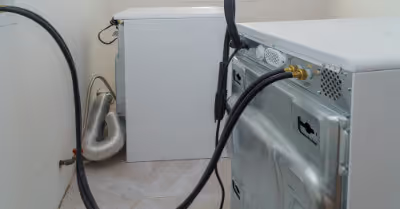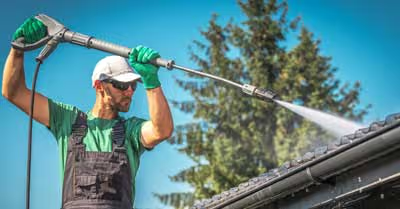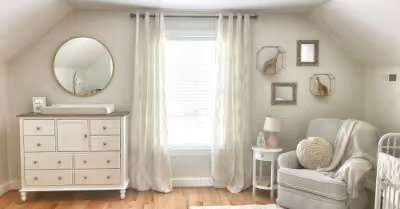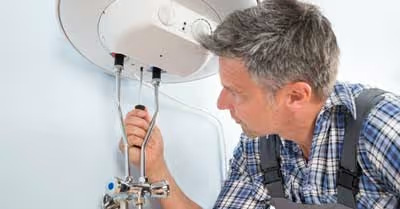Table of Contents
Type of HVAC System
Before you decide on anything else, you need to look into different types of systems so you can find the one that best suits your needs.
Split System
Split HVAC systems are the most popular of the types. Split systems have two components that are split up. This means there will be one component indoor and one outdoor. There are a few different configurations that are all referred to as split.
Split systems are an affordable, yet efficient, HVAC option. However, they do require ductwork so if you don’t have ducts, it may not be the most cost-effective solution to your heating and cooling needs.
Air Conditioner and Furnace
This system has a furnace inside with the evaporator coil. Most HVAC systems use a gas furnace, but around 5 percent use an oil one. Then you have the air conditioner unit located outside.
This system works by capturing heat with the evaporator coil. The heat is then sent outside with refrigerant inside copper. If you live in a warm climate, you should look for a high efficiency air conditioner unit.
Heat Pump and Furnace
This split system has two sources of heat. It can also be called a hybrid heat system. If you live in a cold area, this is definitely an option to consider. The heat pump will give you heat when it is fairly cold, but it switches to the furnace when it gets below freezing.
Split Heat Pump System
This option is for warmer climates that rarely, if ever, get below freezing. This system uses a heat pump to cool and heat your home. A heat pump works in a similar way to an air conditioner except you can reverse this action when it gets cold. This method requires an air handler in place of a furnace.
Packaged Systems
This system, unlike the split systems, will have all of the components together. This is a popular option if you have the room for this. Again, there are a few different types, but all of them use a blower to get the air into the home.
Packaged systems are usually used when you can’t install a split system. They are less efficient and, since all of the parts are outside, often wear out faster.
Heat Pump
This system has a single unit for both air conditioning and heating. Generally, the unit will be placed on the roof or just outside of the building. This option is good for very cold areas. They are known for being very efficient.
Air Conditioner and Furnace
Air conditioner and furnace package systems are more powerful than heat pump packaged systems, yet remain efficient. They are also usually found in colder regions.
Hybrid
This unit is also called a dual fuel packaged system. It uses both a heat pump and a furnace. If the temperature isn’t too cold, the heat pump will heat and cool the building. However, when it gets cold, the furnace will take on the responsibility of keeping you warm. This is a great option if efficiency is important to you.
Ductless System
These systems have two components - an air conditioner and a heat pump. It will use a heat pump for cooling and heating. It will also use an air conditioner to cool your home.
If you don’t currently have ducts, this may be a cost-effective choice. They can have great efficiency and help you save money on energy. However, they are not recommended for cold climates.
Geothermal System
The final option is a geothermal system that uses the earth’s temperatures to regulate your air. Water and refrigerant move through pipes to collect or get rid of heat to keep your house at the correct temperature. This usually means it will gather heat for you during colder months and shed the heat in the summer.
This is a fantastic option is you are looking for the best energy efficiency. You will pay more for these systems, up to 5 times as much, while saving 3 to 4 times as much energy.
Type of Compressor
In addition to choosing a type of system, it is also good to know about the different types of compressors available for your HVAC unit. Each one has its own pros and cons.
Single Stage
A single stage compressor runs on one speed to cool the home. This causes the compressor to turn off and on in order to regulate the temperature. This uses more energy because it is always running at the highest capacity.
Two Stage
As the name suggests, this compressor has two stages. It will run on high when it is hot and on medium when it is cooler. The high stage kicks on when it gets hot outside in order to save energy. Depending on your climate, this can be a very energy efficient option.
This choice tends to make your air more comfortable than single stage compressors because it helps to reduce the humidity inside. This also contributes to energy efficiency because you don’t have to have the thermostat as cool. It will, however, cost more than a single stage compressor.
Types of Condenser Fan Motors
The condenser fan motor is a part on the outside air conditioning unit. The purpose of the fan is to keep the compressor cool. There are two different types to look at.
Single Stage
A single stage fan motor only runs at one speed. It costs more than variable speed motors. It also tends to be loud.
Variable Speed
The speed of a variable speed motor changes in relation to the outside temperature. This is an energy efficient option compared to single stage motors. This is especially true in mild climates because it will run at a lower speed most of the time.
Size of HVAC Unit
One of the main considerations when choosing an HVAC unit is the size. A unit that is too small will have trouble heating or cooling the entire building. In contrast, a unit that is too big won’t be efficient and can wear out faster than you’d like.
To determine the size, you start with the square footage. It doesn’t have to be exact, but the closer the better. The second number you will need for the calculation is the base BTU, or British Thermal Unit. You can use the approximate number of 25 because that is close to the amount of energy required for each square foot. Now, multiply 25 times the amount of square feet.
But what is this number? It is the number of BTUs your home needs. For A/C units, divide the total BTUs by 12,000 to get the tonnage. For furnace units, you take the percentage efficiency (move the decimal two places to the write to turn it into a decimal) and multiply it by the total BTUs.
This is very approximate because it doesn’t take other factors into account. If you need to account for the number of people, number of windows and placement, insulation, and lighting, you should think about talking to an HVAC professional.
Energy Efficiency and Price
This table ranks the energy efficiency and provides the average cost of the different types of HVAC systems.. For efficiency, 1 will be the most efficient and 8 will be the least efficient.
Recent Articles
















